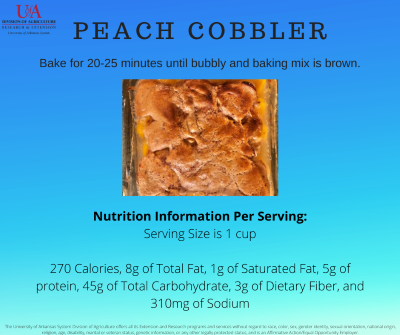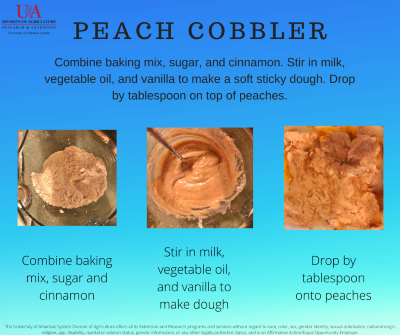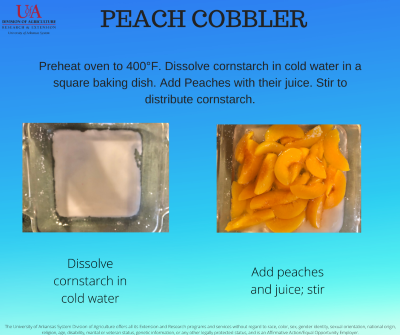Tasty Thursday with Tori: Peach Cobbler

At Home with UAEX
Learn from the best Extension Educators on being at home with UAEX!
Tasty Thursday with Tori: Peach Cobbler
Original Author: Tori Copeland, Lawrence County | Adapted for Blog: Torrie Smith,
Van Buren County
Peaches are an excellent source of Vitamin A and Vitamin C. They are fat-free and cholesterol free making them a great option for snacks or desserts! When you buy peaches they are classified as freestone, meaning they easily separate from their pit, or they are clingstone, they hold onto the pit. They have their best flavor when they are golden in color, slightly soft, and free of bruises. It is best to avoid green colored peaches, as this means they are not yet ripe and they will not become sweeter as the color changes. Remember, if it smells like a peach, it’s ready to eat.
To help you peel fresh peaches, dip them in boiling water for 20-30 seconds, followed by immediately putting them into cold water. This will allow the skin to slide right off. More ripe fruit will need less scalding time to loosen peels. Peaches brown rapidly when exposed to air. If peeling or cutting up peaches for a recipe, keep them from turning brown by sprinkling with lemon or orange juice.
Step one:
Preheat oven to 400°F. Dissolve cornstarch in cold water in a square baking dish. Add peaches in their juice. Stir to distribute cornstarch.

Step two:
Combine baking mix, sugar, and cinnamon. Stir in milk, vegetable oil, and vanilla to make a soft sticky dough. Drop by tablespoon on top of peaches.

Step three:
Bake for 20-25 minutes until bubbly and baking mix brown.

- 2 teaspoons cornstarch
- 2 tablespoons cold water
- 1 (14.5 oz) can sliced peaches, in juice
- 1 cup baking mix
- 2 tablespoons brown sugar
- ½ teaspoon cinnamon
- 6 tablespoons skim milk
- 2 tablespoons vegetables oil
- ½ teaspoon vanilla extract
Preheat oven to 400°F. Dissolve cornstarch in cold water in a square baking dish. Add peaches in their juice. Stir to distribute cornstarch. Combine baking mix, sugar, and cinnamon. Stir in milk, vegetable oil, and vanilla to make a soft sticky dough. Drop by tablespoon on top of peaches. Bake for 20-25 minutes until bubbly and baking mix brown.
Serving Size: 1 Cup
270 Calories, 8 grams of total Fat, 1 gram of Saturated Fat, 5 grams of protein, 45 grams of Total Carbohydrate, 3 grams of Dietary Fiber, and 310 milligrams of Sodium
This recipe came from the University of Arkansas System Division of Agriculture Cooperative Extension Service’s Cooking with Extension Cookbook and the information comes from the Arkansas Foods Let’s eat some… Peaches. For more information on peaches, contact your local extension agent!
